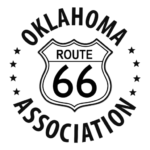Description
Visit Edmond is passionate about welcoming visitors. Many travel to Edmond via Route 66. Here is a little history about Edmond:
First explored by Washington Irving in 1832, Edmond was part of the Unassigned Lands, territory that was not assigned to any Native American tribe living in the area. The area was open to exploration, inhabited by herds of buffalo, black bears and wild horses, and used for hunting by nearby tribes.
On July 4, 1884, Congress granted rights to railroad companies to build tracks across the territory. By 1887, railroads were running across the Unassigned Lands. That year the train station, first named Summit for being the highest point of the railway between the Cimarron and North Canadian rivers, was officially renamed Edmond.
The first settlers lead to many more firsts for our great city:
- First public school house, 1889 Territorial Schoolhouse at 2nd and Boulevard
- First flour mill in 1894, the Eagle Flouring Mill on 1st west of the railroad tracks
- First newspaper, the Edmond Sun at 2nd and Broadway, which closed in 2020
- First public institution of higher education, the Territorial Normal School, now the University of Central Oklahoma at 2nd and University
In the 1980s, nearly 100 years after the Land Run that started the City of Edmond, Hafer Park opened, the site for Arcadia Lake was dedicated and the Oak Tree Country Club was being built. Today, Edmond boasts a population of nearly 95,000. Several historic sites built throughout our city’s history remain standing, like the 1889 Territorial Schoolhouse, the Rodkey grain elevator, and the University of Central Oklahoma’s Old North. Edmond has grown exceedingly well in the past 130 years, and we are still growing.





